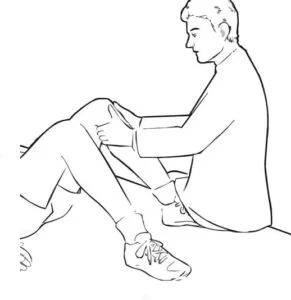Anterior and Posterior Drawer test of Knee joint:
Anterior and Posterior Drawer test are mostly used for the examination of Knee joint pain related condition if Doctor suspect that there may be Anterior Cruciate ligament injury or Posterior Cruciate ligament injury for Differential Diagnosis.
What is the part of this test ?
- Anterior drawer test
- Posterior Drawer Test
- This test is used to the the initial clinical assessment of to the suspected rupture of to the cruciate ligaments of the knee.
- It is help to the doctor for the examination of the knee pain.
- It is also check the stability of the ligament .
Anterior drawer test :
Purpose of this test :
- This test is check the integrity of to the anterior cruciate ligament means ACL.
- It is also check the one plane anterior instability.
How to perform of this test?

- Position of the patient for the test is supine.
- In the supine position onto the plinth with the hips are flexed up to the 45 degrees with the knees are flexed up to the 90 degrees & feet is flat onto the plinth.
- The n examiner sits on to the toes for the tested which is do the extremity of to the help in the stabilize it. after that the examiner is grasps to the proximal lower leg & distally this leg is in the tibial plateau / joint line of tibiofemoral.
- Examiner is attempts to the translate of the lower leg in anteriorly.
- This test is considered to positive when the lack of end feel & excessive of the anterior translation which is compare with the contra lateral side.
- This test is also perform into the sitting position .
90 -90 anterior drawer test :
- This test is describe by the weatherwax .
- Patient position is supine.
- Then examiner flexes the patient’s hip & knee to 90 ‘ & support to the lower leg between the examiner ‘s trunk & forearm .
- After that examiner places the hand around the tibia & slowly lift the patient’s buttock off the table.
Which is the Clinical Note of this test ?
- Examination of this test is perform with the particular care because the starting position is the result into the of the false-positive of the anterior drawer test which is the result of to the anterior cruciate ligament. if the posterior sag which is an indication of the posterior cruciate problem is goes the unnoticed before the test is started.
- If minimal / no swelling is present, so that the sag is evident because of that an obvious concavity is distal onto the patella.
- When the anterior drawer test is the done, therapist feel the audible snap or palpable the jerk
- This sign is known as the Finochietto jumping sign.
- It is occurs due to the tibia is pulled to the forward & the tibia is moves to the forward, Which is the excessively of the a meniscal lesion.
What is interpretation of this test?
- In this test tibia is drawn forward on to the femur.
- So that the normal movement is do the approximately to the 6 mm.
- But if the movement is do the more than 6 mm on the femur .
- This situation positive of the test .
Which is the structure is injured during of the test ?
- Anterior cruciate ligament
- Medial collateral ligament
- Arcuate – popliteus complex
- Posteromedial capsule
- Postero lateral capsule
- Posterior oblique ligament
- Iliotibial band
What is the diagnosis accuracy of the test ?
- Sensitivity = 40.9%
- Specificity = 98.4%
Posterior Drawer Test :
Purpose of this test :
- The test is check to the integrity of to the posterior cruciate ligament means PCL.
- This test is also check to the one plane posterior instability .
How to the perform of this test ?

- Patient position for the test is supine .
- In the supine position flexed to the knee approximately of the 90 degrees.
- After that the examiner is sits on to the toes for to the extremity which is help to the stabilize it.
- Then examiner is grasps to the proximal lower leg, approximately to the tibial plateau / joint line with to the thumbs is placed onto the tibial tuberosity.
- After that the examiner is attempts of to the translate of to the lower leg posteriorly.
What is interpretation of this test ?
- In this test the tibia is pushed back on the femur .
- This test is positive when the lack of end feel / excessive of to the posterior translation.
- If the see the posterior sag sign it is also positive this test .
Which is to the structure is injured during of this test ?
- Posterior cruciate ligament
- Anterior cruciate ligament
- Posterior oblique ligament
- Arcuate – popliteus complex
Diagnosis accuracy of this test :
- Sensitivity = 90
- specificity = 99
- -LR [ Negative Likelihood Ratio ]= 10
- +LR [ Positive Likelihood Ratio ] = 90



![Test for tight retinacular [ collateral ] ligaments.](https://mobilephysiotherapyclinic.in/wp-content/uploads/2022/02/test-for-tight-retinacular-ligaments.jpg)



